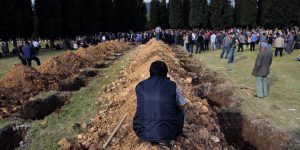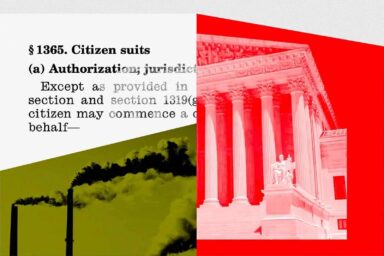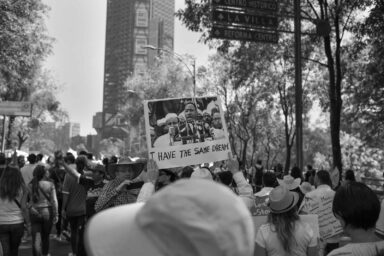Turkey’s rush to privatize state assets and mine its natural resources is turning a nation blessed with tremendous clean energy potential into a dirtier one. And it’s not just the environment that’s polluted. James Ryan investigates from Istanbul.

All it took was 19 years, more than a thousand deaths, a reputation as a world-class killer of coal miners, and, finally, a mine named Eynez in Soma that killed 301 miners in one horrific blow, leaving 432 children fatherless.
On December 4, 2014, eight months after the worst mining disaster in Turkish history, the nation’s parliament finally signed the international Safety and Health in Mines Convention.

At least some of the miners might been saved if refuge chambers—providing oxygen, food, water, first-aid kits—were available in the mine. But Turkey had resisted signing the Safety and Health Convention since its adoption by the International Labor Organization in 1995. And as long as no law required the Soma mine owners to build refuge chambers, none had been erected.
Soma is the coal capital of Turkey’s Aegean region, an area in the northwest of the country that is dense with deposits of a soft coal called lignite. Lignite mining is a notoriously dirty business.
Lignite-burning power plants emit more harmful greenhouse gases, primarily carbon dioxide, than those using hard coal, fuel oil or natural gas. Indeed, according to the European Environment Agency’s authoritative analysis, lignite is almost twice as dirty as natural gas.
Energy for Sale in Windy Troy
The government of President Recep Tayyip Erdogan has ambitions to make Turkey many things, among them an international energy hub, selling cheap power to the world. Hence, its drive to build more lignite-burning power plants in what’s known as the Soma Basin. In addition to the seventeen plants already in operation, another 46 are under construction or on the drawing board.
There’s an irony to the plan to turn the Aegean region into a world-class hydrocarbon polluter. This part of Turkey is naturally blessed with an abundance of clean-energy alternatives. Not for nothing did Homer call it “windy Troy.” And it is renowned for its sun-drenched olive groves.
A detailed study by Bloomberg Finance suggests that a strategic turn toward developing Turkey’s wind, solar, and geothermal resources would satisfy all of its future power needs at no greater cost than its ongoing, hydrocarbon-heavy “dirty” option.
***
But closing the coal mines would not jibe with the ruling party’s political and financial objectives–which include rewarding its voting constituencies with cheap home-heating fuel, and earning lucrative royalties when the state coal authority grants mining rights to favored private companies.
What Price Privatization?
In fact, since Erdogan’s party came to power in 2003, Turkey has been on a privatization binge. There’s been a dramatic 83% reduction in the production cost of lignite under privatization, from $140 to $23.80 per ton. But the money saved has not gone to the miners.
Most miners now work for non-union “subcontractors.” They earn low wages (1500 Turkish lira per month, or about $667) and have no severance pay, no health insurance, no vacation or overtime, and no bargaining power.
Breaking the power of mine unions has evidently proved rewarding for the mine owners. There were 358,000 employees working for subcontractors in 2002; today there are 2.5 million.
Air pollution from proliferating lignite mines is only one ecological insult linked to Turkey’s breakneck rush to expand and privatize its industrial base.
In today’s Turkey, virtually all state assets are for sale.
***
When then-prime minister Erdogan proclaimed that the country’s rivers must no longer “run in vain” and that 100% of their hydroelectric potential should be captured by new dams, he meant it literally. In the coming decade, 90% of the water taken from the nation’s river system will be turning turbines in 4,000 privately-owned hydroelectric plants.
The State Hydraulic Works estimates that two million people could be displaced by this vast construction program alone. More will lose their homes in the wake of other large-scale projects scheduled for completion by 2023, the centennial of the establishment of the Turkish Republic.
These projects include a new 30-mile canal parallel to the Bosporus strait; three nuclear reactors being constructed around a country that is one of the most seismically active on Earth; a third suspension bridge over the Bosporus; a massive third international airport and an enormous mosque, designed to hold 60,000 worshippers, on the highest hill in Istanbul.
Skip the Environmental Impact Reports, Please
The impact of all this construction on the environment? Undoubtedly profound, but it’s hard to get a clear picture from the government’s environmental impact process. Impatient with time-consuming scientific analyses and evaluations, the government passed a series of laws allowing the “rapid expropriation” of land for large projects. Thus, work begins before the environmental impact is assessed.
These preemptive strikes on virgin land typically render moot any attempts to preserve the environment. For example, millions of trees have been and will continue to be cut down while awaiting determination of the ecological consequences.
Turkey, a geopolitically sensitive land bridge between Asia, the Middle East and Europe, has been a modern, secular, democratic state since 1923. For over a decade it has been ruled by an Islamist government under Recep Tayyip Erdogan.
Construction of his multi-billion dollar palace complex, built on protected land, was ruled illegal by the Council of State, the highest administrative court in the land. Erdogan’s response: “Let them tear it down if they can.”
For Mourners, a Lecture
Welcome to Soma. On the day the mass burials began on May 14, 2014, Erdogan, then prime minister, came to visit the suffering town. Bizarrely, he lectured the assembled townspeople on the place of the local disaster in global history, citing a list of mining accidents around the world stretching back to the mid-19th century.
“These are the usual things,” he said. “I went back in British history…some 204 people died there after a mine collapsed in 1838.”

When he finished, the grieving people jeered. There were angry words, shouts, fists upraised, pushing, punching; a photo of an Erdogan advisor kicking a demonstrator whom two policemen had already subdued on the ground went viral. For Erdogan, there were no political consequences. Three months later, he was easily elected president.
Double Disaster
Six months after Soma, another mine disaster happened in a town called Ermenek. Eighteen miners died when the gallery where they were working flooded.
Critics of the government charge that the Ermenek mine should never have been opened.
In fact, it was closed for two months following the Soma disaster, ostensibly to correct water and gas leakage that threatened the integrity of the underground galleries. The mine reopened in August, despite the fact that the requisite repairs had not been made.
Just days before the disaster, Turkey’s state mining directorate warned the Ermenek mine operators to correct the problems, but they took no action. Investigators later found the directorate at fault for allowing the mine to reopen.
Police arrested Saffet Uyar, the mine’s owner, charged him with “purposefully neglected murder.”
Unmentioned in the official report on the causes of the Ermenek disaster was seepage from the Ermenek Dam, one of the government’s showpiece hydroelectric projects. Completed in 2009 only three miles from the Ermenek mine, it is one of the tallest dams in Turkey at 689 feet.
As a consequence of not having the Ermenek River “run in vain,” underground water levels have been elevated by approximately 295 feet. This has led to flooding in nearby mines and subjected the walls of underground galleries to greatly heightened hydrostatic pressure, making them susceptible to bursting.
Recommendations from geologists to drill wells in the mines, to lower water levels and so relieve the pressure, went unheeded.
It has since been reported that eight of the Ermenek miners did not drown but died from methane poisoning from released coal gas. As at Soma, a refuge chamber might have saved them.
Still Seeking Refuge
Turkey’s signing of the international Safety and Health in Mines Convention may herald a cleaner future for coal mining in the country.
But the convention is no panacea. There is nothing in its provisions that specifically directs mine operators to provide refuge chambers, although these are standard in virtually all other coal-mining nations. And the Turkish government’s record in mandating costly measures to protect the health of miners is not encouraging.
Less than a month after the Soma catastrophe, the Turkish ruling party defeated a resolution in committee to make refuge chambers mandatory. And in November, three weeks before it approved the convention, parliament again had the opportunity to mandate refuge chambers.
Instead, it voted for a vastly cheaper alternative: placing microchips in workers’ helmet lamps, thereby making it easier to locate trapped miners—or their corpses.
If the mutually profitable collusion between the government and mine bosses continues, Turkey can expect to reap more tragedy from its “dirty energy” boom.



